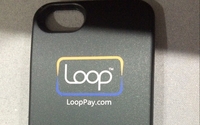 I’ve always viewed the smartphone as the hub of mobile
commerce.
I’ve always viewed the smartphone as the hub of mobile
commerce.
While my Fitbit tracks my steps taken, stairs climbed and miles walked, it takes a Bluetooth-linked smartphone to see the detailed results.
But mobile commerce sometimes
involves more than a smartphone.
While I’ve been using mobile payments via Android for some time, paying at checkout with my iPhone has been a bit more challenging.
While payment
apps like Square and LevelUp work great where accepted, it’s been a bit tougher to pay everywhere for physical goods.
I recently got a LoopPay iPhone case, which turned my iPhone 5 into
a payment device.
Since last year, I’ve been using the Loop payment FOB, which works at any payment terminal where a credit card can be swiped. You hold the device near the credit card
reader, push a button and payment is executed. The system essentially transmits the same information as a credit card magnetic swipe.
The iPhone case does the same thing, minus the FOB.
More interesting than the technology is the wow reaction I consistently get from cashiers when they see the device work. Maybe it’s the novelty factor of seeing a transaction occur
without a credit card.
A bonus of the iPhone case is it’s also a battery charger for the phone, with a short cord that connects directly to the phone.
This part isn’t so
important to me, since I generally carry additional battery power to assist my heavy phone usage.
For business trips, I take along my dual port battery pack and charger (8000mAh) that I bought
online from Monoprice, at the trusted recommendation of my son the videographer, who has to carry serious power back up for multiple GoPros on major shoots. The thing charges two phones a couple of
times.
(For day-to-day trips I carry the much lighter and cooler-looking Tego Power Grid (4,200mAh), which also can charge two phones.)
We’ll be interested to see how many people
will supplement their mobile phone with an add-on device, though consumers already are used to using multiple technological devices (remote-control roulette, anyone?)
For example, I’ve
had a Garmin GPS in my car for years, though I rely on Google Navigation on my Galaxy S4 to check traffic along the way as well as validate it’s the best route. The GPS is an indicator while the
smartphone is the hub.
And when I leave my car, I load my Take Me to My Car app, tap Park Here, and then always have easy directions back to it, especially when a rental car in a
different city.
While at Staples picking up some office supplies over the weekend, I decided to get a new GPS mount for my dashboard.
As usual before checkout, I scanned the barcode
with ShopSavvy, found a competitor’s price and Staples instantly matched it, giving me a 45% discount.
Since I had coupons stored in my app from previous purchases, I used one of those
to pay for everything.
It turned out my coupon was worth more than my purchase, so Staples owed me.
Somewhat ironically, while much of the commerce activity was done digitally via
smartphone apps, the excess coupon value was handed to me in the form of a paper receipt.
Sometimes it takes more than just a smartphone.
All the major
issues relating to mobile commerce will be discussed at the MediaPost OMMA mCommerce conference in New York on Aug. 7. You can
check out the agenda where you also can register to attend. Will I see you there?